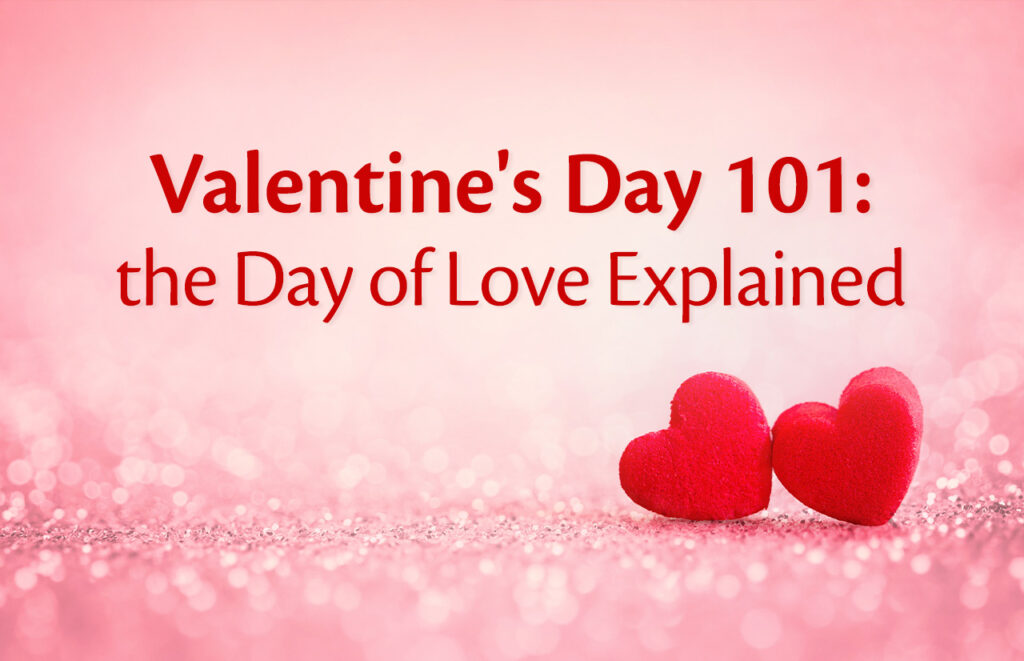Heart-shaped candy, chocolates, roses and cards line store shelves. Shades of red and pink pop up everywhere. Love is in the air. This can only mean one thing: Valentine’s Day is fast approaching.
While Valentine’s Day has long been associated with fancy dinners for two and a proliferation of sweet desserts and gifts, at its core, it’s really about something we can all use a little more of: love.
That’s right! Minus all the pressure associated with the holiday, it’s a chance to celebrate love in all its forms. And though we all have an opinion on the holiday and what it means to us, one question that few consider is: how did this day of love come to be?
The truth is that Valentine’s Day has a long and storied history which traces back to ancient Rome, and it’s not as rosy as one might expect. In fact, its origins are quite dark and even bloody. Are you ready to find out?
Table of Contents
Where Does the Word “Valentine” Come From?
While the true history behind Valentine’s Day is a bit murky, it’s possible that the love-filled holiday originated in ancient Rome from a combination of various saints named Valentine or Valentinus. Here are two stories commonly referenced as the origin of the holiday:
Story #1. It’s believed that the Catholic Church may have established Valentine’s Day to honor two Saint Valentines who were executed on February 14 of different years in the third century. One of the men, Saint Valentine of Terni, had been secretly officiating weddings for Roman soldiers against the emperors wishes, making him, in some eyes, a proponent of love.
Story #2. Another story involves the practice of writing love letters to your Valentine. It’s said an imprisoned St. Valentine wrote the first “valentine” letter to a young girl – possibly his jailor’s daughter – who he tutored and fell in love with. It is alleged that he signed the letter “From your Valentine,” an expression that is still used today.
What Is Lupercalia and How Is It Related to Valentine’s Day?
An even more “wild” possible origin story, some believe that the ancient pagan festival Lupercalia gave rise to what we now know as Valentine’s Day. A festival marked by debauchery, sacrifice and drunkenness, it is thought that Pope Gelasius I eventually forbid the celebration of Lupercalia and replaced it with Valentine’s Day.
So, what is all the hoopla surrounding this crazy festival?
Occurring every February 15 in ancient Rome, Lupercalia promoted health and fertility while celebrating the coming of spring. The festival hosted a matchmaking lottery where young men would randomly choose a woman’s name from a jar to be coupled with them for the duration of the festival – or longer, if the match was right.
The festival included a ritual where Roman priests would gather to sacrifice a goat, for fertility, and a dog, for purification. The priests would then run naked through the streets, gently slapping women with the blood-soaked hides of the sacrificed animals, which they believed promoted fertility.
While Lupercalia has since become the stuff of legend, many symbols of the holiday are still used for Valentine’s Day, intentionally or not. For example, the color red represented a blood sacrifice, while the color white represented the milk used to wipe blood clean and symbolizes new life and reproduction.
Why Is Cupid the Symbol of Valentine’s Day?
Many holidays feature an instantly recognizable mascot. Christmas has Santa Claus. Easter has the Easter Bunny. And, of course, Halloween has witches, goblins and ghosts. But Valentine’s Day may have the cutest of them all: Cupid, the adorable warrior of romance.
Usually depicted as a winged, chubby little boy, this mischievous cherub flies around shooting arrows of love at people. So how did he become such an enduring symbol of Valentine’s Day?
Cupid’s origins can be traced to ancient Greece. As the son of Aphrodite and Ares, Cupid was originally called Eros, the Greek word for desire. Eros was more of a muscular heartthrob than a cherub and would play with the hearts of mortals and gods to cause mayhem. When the Roman era began, they chose to bring over the more recent iteration of the god: a cute little boy. They named him Cupid, a synonym for Eros that translates to “desire.”
By the turn of the 19th century, Cupid had become linked to Valentine’s Day for his love-creating abilities. Greeting-card manufacturers started making products that included imagery of Cupid inspired by beloved Renaissance art. Cupid imagery only grew more prevalent over time and today you’ll find him in Valentine’s Day cards, decorations, floral arrangements and many romantic gifts.
How Is Valentine’s Day Celebrated Today?
Mostly associated with romantic love, Valentine’s Day continues to be a celebration for lovers. One can expect fancy restaurants to be swarmed with dinner reservations and the flower section of the grocery store to be packed with last-minute gift-givers. Marriage proposals are also popular on Valentine’s Day, and it is often chosen as the perfect day to express love and commitment.
However, it isn’t just couples celebrating Valentine’s Day anymore. Valentine’s Day has become a celebration of love in all its forms – between family members and friends – in addition to romantic couples. In school, classmates can share cards with their peers along with tasty treats like cupcakes or chocolates. Mothers and fathers can give their children meaningful tokens of their love. And, friends can show appreciation for each other just because they’re awesome.
In fact, over the past few years, and thanks a lot to the TV show “Parks and Recreation,” the “unofficial” holiday of Galantine’s Day has made its way into the spotlight. Celebrated on February 13, the day before Valentine’s Day, Galantine’s Day honors friendship in every way. It’s the perfect occasion to recognize all your non-romantic relationships and a fun excuse to shower your best friends with gifts, love and some quality time.
Whoever said the holiday season ends after New Year’s? Valentine’s Day season is also a great chance to keep holiday spirit alive through the month of February. Miss all the Christmas decor? Give your home the Valentine’s Day treatment with pink and red lights, a heart-themed wreath and other festive enhancements. Need something to watch that’s fitting for the holiday? Move over Christmas movies, it’s time for romantic comedies to shine! And let’s not forget about desserts: chocolate strawberries and heart-shaped cookies anyone?
Maybe Valentine’s Day is the “most wonderful time of the year” after all.
We hope today’s article was both informative and fun and that it helped prepare you better for the upcoming season of love. And if you wish to spread a little love this Valentine’s Day, The Bradford Exchange offers an incredible selection of Valentine’s Day gifts, from exquisite fine jewelry to unique collectibles and keepsakes. We hope you will discover treasures that touch the hearts of all the special people in your life. Happy Valentine’s Day!
Valentine's Day 101: the Day of Love Explained by The Bradford Exchange
